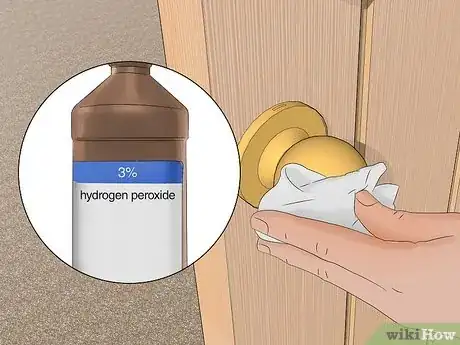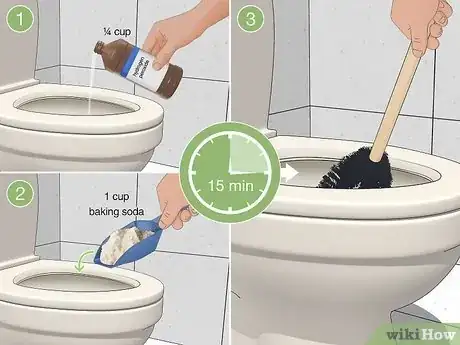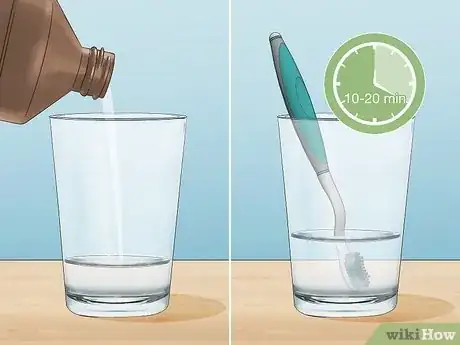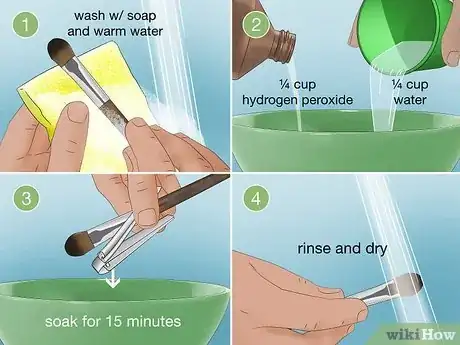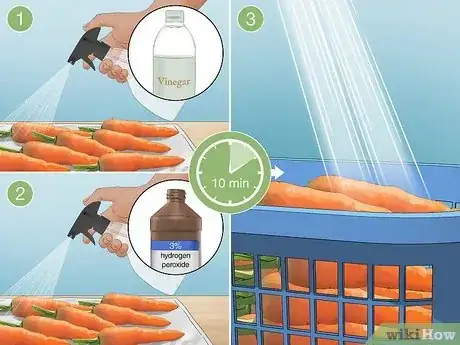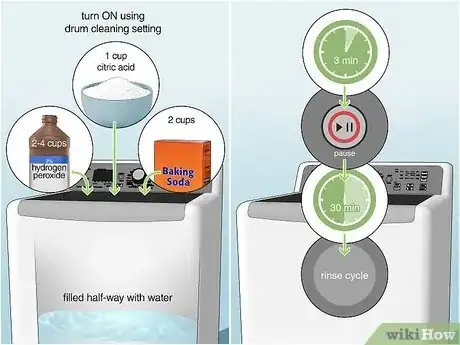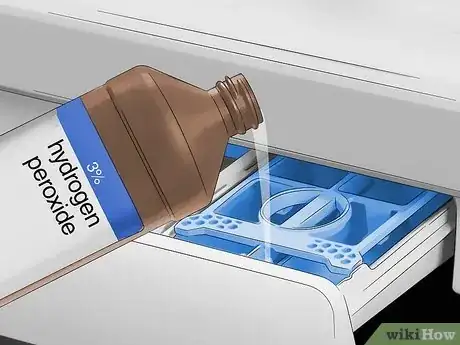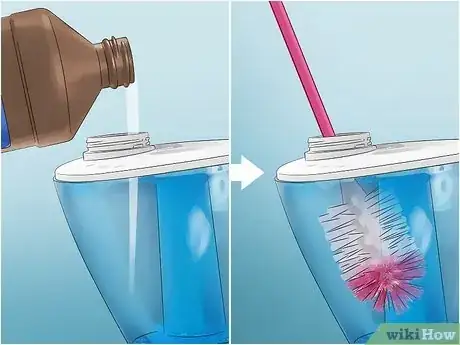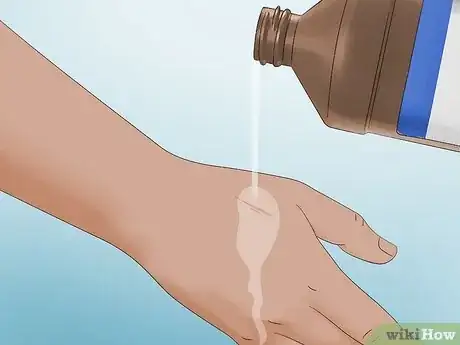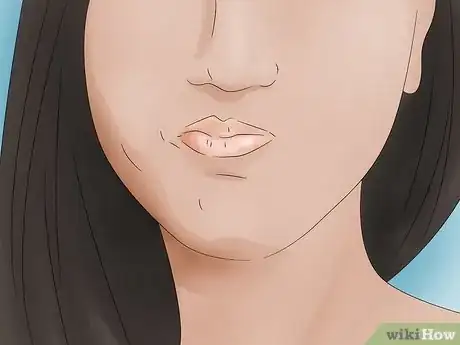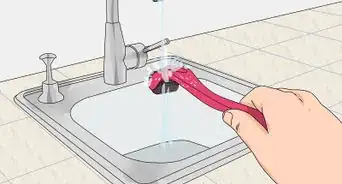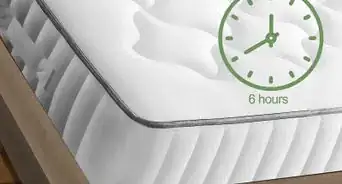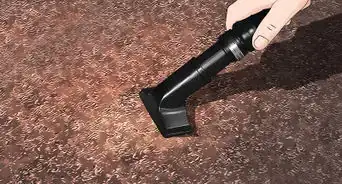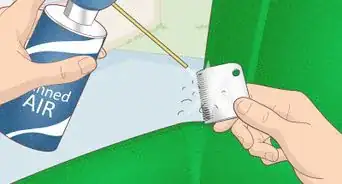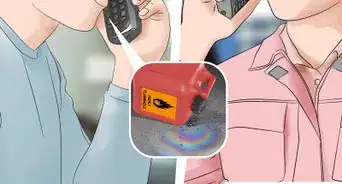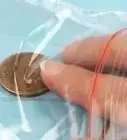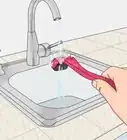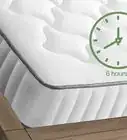This article was co-authored by Brandon Beckwith and by wikiHow staff writer, Madeleine Flamiano. Brandon Beckwith is a House Cleaning Specialist and the CEO of Reliable Housekeeping in Sacramento, California. Brandon and his team specialize in house cleaning such as maintenance cleaning, deep cleaning, move in/out cleaning, apartment cleaning, as well as commercial cleaning, window cleaning, and carpet cleaning. All members of the Reliable Housekeeping team receive background checks and professional training. Their family-owned and operated business is licensed, insured, and bonded.
There are 17 references cited in this article, which can be found at the bottom of the page.
This article has been viewed 1,496 times.
Hydrogen peroxide is a miraculous multipurpose cleaner—plus, you probably already have it in your medicine cabinet! If you'd like to set to work on a bunch of household tasks, one bottle of hydrogen peroxide can accomplish so much. We'll tell you how to use it to sanitize or disinfect surfaces in each room of your house, from the bedroom to the kitchen. Read on to learn all the DIY projects in store for you when you have some peroxide within reach.
Steps
Expert Q&A
-
QuestionCan you use 12% hydrogen peroxide?
 Brandon BeckwithBrandon Beckwith is a House Cleaning Specialist and the CEO of Reliable Housekeeping in Sacramento, California. Brandon and his team specialize in house cleaning such as maintenance cleaning, deep cleaning, move in/out cleaning, apartment cleaning, as well as commercial cleaning, window cleaning, and carpet cleaning. All members of the Reliable Housekeeping team receive background checks and professional training. Their family-owned and operated business is licensed, insured, and bonded.
Brandon BeckwithBrandon Beckwith is a House Cleaning Specialist and the CEO of Reliable Housekeeping in Sacramento, California. Brandon and his team specialize in house cleaning such as maintenance cleaning, deep cleaning, move in/out cleaning, apartment cleaning, as well as commercial cleaning, window cleaning, and carpet cleaning. All members of the Reliable Housekeeping team receive background checks and professional training. Their family-owned and operated business is licensed, insured, and bonded.
House Cleaning Specialist Definitely—just be sure to dilute it with water first. A bottle of 12% hydrogen peroxide is highly concentrated, so you'd want to dilute it with water at a 1:9 ratio or so.
Definitely—just be sure to dilute it with water first. A bottle of 12% hydrogen peroxide is highly concentrated, so you'd want to dilute it with water at a 1:9 ratio or so.
Warnings
- Never mix hydrogen peroxide and either vinegar or bleach in the same container. These combinations release toxic gasses.⧼thumbs_response⧽
- Avoid directly inhaling hydrogen peroxide.[19]⧼thumbs_response⧽
- Since hydrogen peroxide is highly combustible, do not store any mixtures you’ve made with it.[20]⧼thumbs_response⧽
- Prevent exposing your eyes or skin to hydrogen peroxide. Wash your eyes or skin with large amounts of water if they come in contact with it, then seek medical attention.[21]⧼thumbs_response⧽
- Be careful when handling higher concentrations of hydrogen peroxide, like 12%. Always dilute it to safer proportions.⧼thumbs_response⧽
References
- ↑ https://ehs.umass.edu/sites/default/files/SOP%20MOD%20Food%20Handler%20Requirments%20COVID_19%20Checklist%20Update%20%285%29.docx
- ↑ https://www.pennmedicine.org/updates/blogs/health-and-wellness/2020/april/cleaning-against-covid
- ↑ https://www.thehealthy.com/first-aid/hydrogen-peroxide-uses/
- ↑ https://www.nytimes.com/wirecutter/guides/how-to-clean-toilet/
- ↑ https://www.chemicalsafetyfacts.org/hydrogen-peroxide/
- ↑ https://www.thehealthy.com/first-aid/hydrogen-peroxide-uses/
- ↑ https://wonderopolis.org/wonder/should-you-use-hydrogen-peroxide-to-clean-cuts-and-scrapes
- ↑ https://www.publichealthontario.ca/-/media/documents/B/2013/bp-cleaning-disinfection-sterilization-hcs.pdf
- ↑ https://www.apartmenttherapy.com/how-to-clean-makeup-brushes-apartment-therapy-tutorials-212122
- ↑ https://www.publichealthontario.ca/-/media/documents/B/2013/bp-cleaning-disinfection-sterilization-hcs.pdf
- ↑ https://www.apartmenttherapy.com/6-ways-to-use-hydrogen-peroxide-to-clean-your-home-236408
- ↑ https://www.swtimes.com/story/lifestyle/2020/09/13/more-ways-hydrogen-peroxide-can-make-your-life-easier/114005928/
- ↑ https://hgic.clemson.edu/factsheet/farm-food-safety-choosing-a-sanitizer-for-washing-fresh-produce/
- ↑ https://www.beyondtoxics.org/wp-content/uploads/GreatNaturalMoldCleaners-Instead-of-Bleach.pdf
- ↑ https://www.mayoclinic.org/diseases-conditions/common-cold/in-depth/humidifiers/art-20048021
- ↑ https://www.mayoclinic.org/first-aid/first-aid-cuts/basics/art-20056711
- ↑ https://dailymed.nlm.nih.gov/dailymed/lookup.cfm?setid=294418aa-640d-42be-ad07-de31da7a7ccc&version=4
- ↑ https://pubchem.ncbi.nlm.nih.gov/compound/Hydrogen-peroxide
- ↑ https://nj.gov/health/eoh/rtkweb/documents/fs/1015.pdf
- ↑ https://nj.gov/health/eoh/rtkweb/documents/fs/1015.pdf
- ↑ https://nj.gov/health/eoh/rtkweb/documents/fs/1015.pdf
